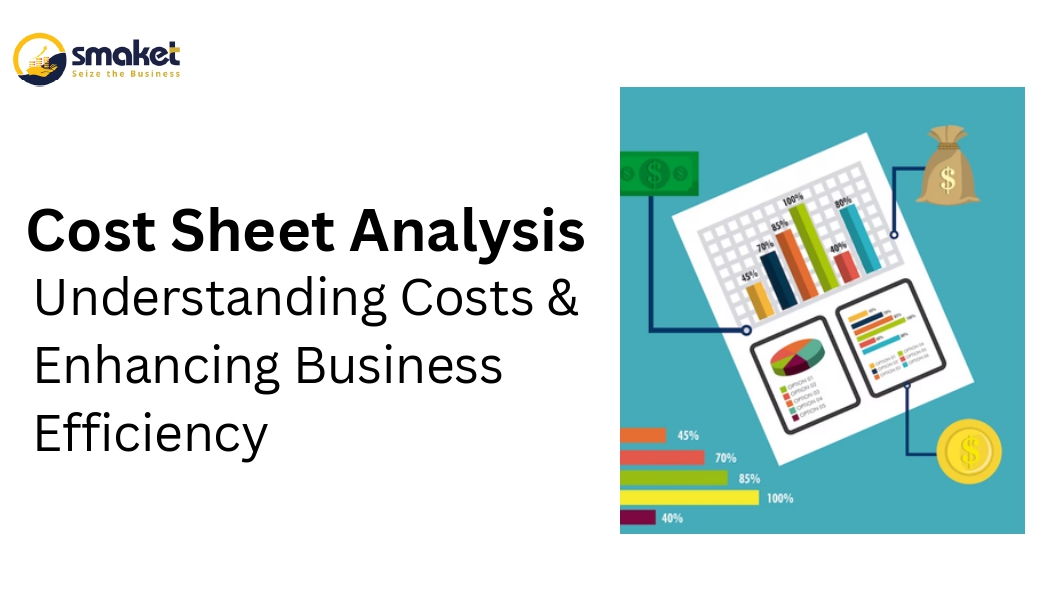Understanding Costs & Enhancing Business Efficiency
Businesses must comprehend the idea of a cost sheet in order to successfully analyse expenses and make wise decisions. This article will examine the purpose, structure, and useful applications of a cost sheet. Understanding cost analysis can help you develop more effective pricing strategies and improve your overall financial management, whether you’re a small business owner or a finance professional.
Meaning and Importance of a Cost Sheet:
A cost sheet is a thorough report that includes every expense a company faces during the manufacturing and selling process. An organisation can decide on the proper pricing for its goods and services by organising and examining these costs. A cost sheet also acts as a standard for monitoring performance, enabling companies to analyse cost variations and pinpoint areas for development.
Components of a Cost Sheet:
There are normally four primary parts to a cost sheet:
Prime cost:
Raw materials, direct labour, and other direct costs linked with the production process are referred to as prime costs. It acts as the starting point price for any goods.
Work cost :
Expenses directly related to the production process, such as factory costs, are included in the works cost, which also includes the prime costs. These overhead expenditures cover things like utilities, upkeep, and other production-related costs.
Cost of Production:
The cost of production includes the price of the job as well as any additional costs connected with running a firm, such as administrative overheads. It also considers changes in the inventory of finished items, which reflects the price of creating things that are ready for sale.
Cost of Sales:
The cost of sales is the overall expense incurred in producing and distributing a good. It helps in determining selling prices and profit margins and offers insights into the overall cost of resources employed in production.
Uses and Benefits of a Cost Sheet:
A cost sheet offers several advantages to businesses:
Accurate Cost Calculation:
Businesses can compute the overall cost and cost per unit of a good or service by carefully examining the cost sheet. Setting competitive rates that cover costs and make a profit is also made easier with the use of this information.
Cost Breakdown:
Cost sheets, which include material costs, taxes, and other pertinent fees, assist firms in understanding the breakdown of costs for each product. This breakdown helps to discover areas where cost savings or performance improvements can also be made.
Pricing Strategies:
Businesses can calculate the selling price based on the cost of manufacturing by using a cost sheet. This also makes it possible to develop pricing strategies that are in line with the resources used to create the product.
Cost Comparison:
Businesses can monitor changes in costs over time by comparing cost sheets from various time periods. This also comparison aids in trend identification, the evaluation of cost-cutting strategies, and the formulation of well-informed cost-control decisions.
Cost management:
Cost sheets give organisations the ability to track and manage costs at every stage by giving them a thorough perspective of production and sales costs. This control aids in streamlining manufacturing procedures and also ensuring effective resource use.
Making decisions:
Cost sheets are essential for making well-informed choices. They give useful information about production costs, assisting companies in determining the viability of new initiatives, gauging their profitability, and also spotting potential cost-cutting opportunities.
Conclusion:
For firms looking to improve their capacity for cost analysis, a well-prepared cost sheet is a useful tool. Companies may decide on pricing wisely, allocate resources optimally, and achieve financial success by comprehending the meaning, format, and also real-world applications of a cost sheet. Integrating cost sheet analysis into your business procedures equips you with better tools to navigate the volatile market environment and achieve sustainable growth.
FAQ:
1. A cost sheet serves what purpose, exactly?
A cost sheet’s primary objective is to calculate the precise cost of a good or service. It also assists companies in cost analysis, pricing setting, and decision-making about resource allocation and cost control.
2. A cost sheet can assist in pricing decisions in what ways?
Businesses can determine the cost per unit of a product by using a cost sheet, which breaks down costs. Using this information, businesses can set prices that are reasonable, cover costs, and generate the required profit margins.
3. Can you compare costs using a cost sheet?
A cost sheet can be a useful tool for evaluating expenditures across several time periods. Businesses can detect trends, assess cost-saving options, and make data-driven decisions to increase cost efficiency by analysing cost variation.
4. What distinct kinds of costs are listed on a cost sheet?
A cost sheet takes into account a variety of costs, including direct costs (related directly to the production process), operating costs (daily costs for maintaining production), and fixed costs (costs of land or equipment, for example, that do not change with the number of products).
5. A cost sheet and a profit and loss statement are comparable, right?
No, a profit and loss statement and a cost sheet have different objectives. A profit and loss statement compares revenues and expenses to determine a company’s profitability, whereas a cost sheet concentrates on figuring out costs per unit and overall product costs.
6. How does a cost sheet help with cost control?
Cost sheets give a thorough overview of manufacturing and sales costs, enabling companies to keep tabs on and also manage costs. Businesses may efficiently manage costs and boost profitability by locating cost-saving possibilities and improving manufacturing processes.
7. Can a cost sheet assist in budgeting?
Cost sheets do indeed play a significant role in budgeting. Businesses can create solid budgets that also direct financial planning, resource allocation, and decision-making by analysing historical data or estimated data.

